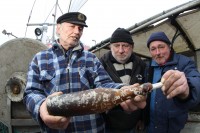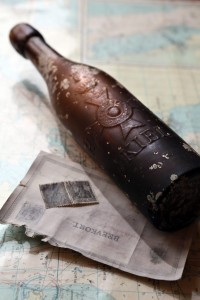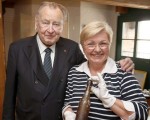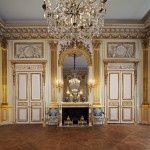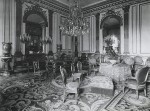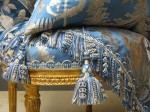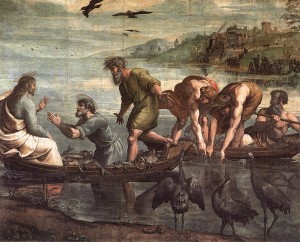The National Museum of Ireland has put together a wonderful video series based on their Viking Ireland exhibit. It’s a tour of Viking history in Ireland as seen through some of the artifacts on display. Each of the eight videos is short and eminently digestible, a sort of capsule history on topics like Viking swords and trade. It also makes you want to go to the museum something fierce, which is obviously the entire point, so job well done, National Museum of Ireland!
The first video is about the Viking battle axe. The stars are three axe heads found together in 2013 in a boat in Lough Corrib, Galway, that date to the 11th or early 12th century. They are three different sizes and, thanks to the survival of small parts of the cherry wood handles still attached to the axe heads and other wood fragments from the rest of the handles, researchers are able to hypothesize that the two smaller ones were probably wielded by one hand, while the largest was probably a two-handed weapon. They’re late enough in date that they almost certainly belonged to Irish warriors, not Vikings. It was the Vikings who brought the battle axe to Ireland. Before that they had axes tools, built heavy to help split wood, but the Viking weapons were designed to be light and sharp, with the maximum amount of cutting edge for minimum amount of weight.
[youtube=http://youtu.be/aYDpXH4adC8&w=430]
Next is the Viking sword, a more expensive weapon than the axe and every warrior’s most prized possession. The video focuses on a sword discovered in the River Shannon near Banagher in 2012. It dates to between 925 and 975 A.D. The blade may be of German manufacture while the hilt was made in Scandinavia. The coolest part of the video is the X-rays of the sword which gave conservators information about which areas needed work and provided more details about manufacture like the use of silver wire in the hilt.
[youtube=http://youtu.be/cKN-lHbCcQs&w=430]
The Viking Wealth & Trade video has some neat shiny stuff like some pretty huge penannular brooches that were both status symbols for the men who wore them and a means of portable wealth. I loved the set of woven silver cones found in a cave in Kilkenny. They aren’t very heavy in silver so they were purely decorative rather than a potential source of bullion. They were probably attached and hung as tassel from the edges of cloth and worn by a woman.
It was Vikings who introduced coin to Ireland. Before they came Ireland was a barter economy, with cattle as the primary currency. The Vikings were introduced to coin by trade with the Byzantine Empire and Arabic merchants and by plundering the Anglo-Saxon kingdoms which minted coins starting in the 7th century. The video shows one of the first coins struck in Ireland, a silver penny from 995-997, struck in Dublin by King Sitric Silkenbeard.
[youtube=http://youtu.be/4Uax54ul_UI&w=430]
The Viking Women in Ireland video is a little thin on details. You see some beautiful ornaments found in graves from pre-Christian burials — large oval brooches used to fasten straps of traditional Scandinavian pinafore with glass bead chains strung between them. The highlight for me is a whalebone plaque similar to the one unearthed in Lilleberge (see this post) which the British Museum speculated might be used for food service, but the National Museum of Ireland thinks were used in textile production, maybe to stretch linen or other fabrics, in conjunction with a glass smoother.
[youtube=http://youtu.be/efZyArUkTxc&w=430]
Arrival of Vikings & Beliefs is centered on remains and artifacts found in burials in Islandbridge, Dublin, the largest Viking burial site outside of Scandinavia. Featured is a skeleton buried with a sword and spearhead, one of the earliest preserved Viking burials in Ireland. There’s also a splendid collection of swords, axes, spearheads and bosses from shields excavated from the 19th century on. Islandbridge excavations are still making new discoveries, including early single-edged sword from the 9th c., a spearhead, ringpin and the human remains of male 18-20 who grew up outside of Ireland and came to the island a couple of years before his death.
[youtube=http://youtu.be/vDYqVTE_ALM&w=430]
The Irish & the Vikings video is about how the two cultures came together. The Vikings created an urban commercial culture with Dublin as the center of trade and manufacture, while the Irish remained rural and agricultural, living in small groups on crannogs and in ringforts. The presence of urban Viking settlements provided new markets for Irish agriculture, cattle, leather, wool. There are some fabulous surviving textiles in the video.
Despite their disparate living arrangements and cultures — the Irish spoke a different language, had different legal and political systems — there was significant overlap in the material culture as the Irish quickly adopted Viking weapons, tools, jewelry. Not to be missed at the 2:51 mark is the Hnefatafl gaming board, a Chinese checkers or draughts sort of game with pegholes in the board decorated in Viking style.
Also striking is the late 10th c./early 11th c. slave chain found near Ardakillen crannog in County Roscommon. There was slavery in Ireland before the Vikings, mainly prisoners of war, but the Vikings made it into a thriving industry. They set up slave emporiums in Dublin, tapping into a vast trade network that meant an Irish war captive could end up anywhere from Scandinavia to north Africa.
[youtube=http://youtu.be/DGbPWErK1_8&w=430]
Daily Life in Viking Ireland looks at the two best preserved Viking settlements: Dublin and Waterford. Because the environment is water-logged, the most exceptional organic remains have been found, like bedding that is still green after 1,000 years. Through a scale model drawn from a Dublin excavation, you see the dawn of the European town design, the six different types of houses, the layout of streets and defenses. Artifacts show the daily life in these towns. Pieces of of walrus bone and tusks were worked there, and there was a huge amber trade. More than 3,000 pieces of Baltic amber from the Viking era have been found in Dublin, the second greatest amount of amber found in Europe.
It’s not just about Vikings and the Irish. There’s an amazing leather scabbard at the 4:13 mark that was made by an English man. We know this because he so generously engraved his name on it: Edric me fecit (Edric made me). Around 4:50 you get an awesome tour of tools — his own and ones for other trades — made by a Dublin blacksmith, including the earliest datable spurs and stirrups in Ireland.
[youtube=http://youtu.be/X0WNJUDuyx0&w=430]
Last but not least is the Legacy of the Vikings in Ireland. By the 10th century, the Viking settlers had intermarried with the Irish and the hybrid Hiberno-Norse brought together Viking and Christian design elements. The Crozier of Clonmacnoise looks like a stylized Viking horse head. The Shrine of the Cathach, a decorated gold box meant to hold a 6th century Irish psalter thought to have been written by Saint Columba himself, is inscribed with the name of its maker: Sitric Mac Maghe (no idea if I’m spelling that correctly), a Scandinavian first name and an Irish family name.
Then there’s the jaw-dropping beauty of the Cross of Cong, a processional cross from the 12th century that was created to hold a fragment of the True Cross. It’s an outstanding example of the late Viking Urnes art style which features stylized animals in combat with snakes symbolizing the battle of good against evil.
[youtube=http://youtu.be/di38rSA8Mmc&w=430]
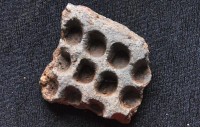 An archaeological survey on the site of future construction in Leicester, central England, has unearthed evidence of an Iron Age mint. More than 20 Iron Age coin molds have been discovered at the Blackfriars site since excavations began in January, so large a number that it strongly suggests the site was a mint used by the local British tribe, the Corieltavi, who had their capital at Leicester.
An archaeological survey on the site of future construction in Leicester, central England, has unearthed evidence of an Iron Age mint. More than 20 Iron Age coin molds have been discovered at the Blackfriars site since excavations began in January, so large a number that it strongly suggests the site was a mint used by the local British tribe, the Corieltavi, who had their capital at Leicester. 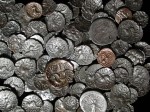 What makes this find particularly exciting is that Leicester is just 15 miles west of Hallaton, the village where a massive treasure including 5,296 British silver and gold coins, 4,835 of them from the Corieltavi tribe, was discovered in 2000. It’s the largest group of Iron Age British coins ever found in Britain. Roman coins and coins from other British tribes were also found at Hallaton, along with a Roman cavalry parade helmet, silver bowls, jewelry, the remains of 400 pigs and several dogs. The site was an open-air shrine in use between 50 B.C. and 60 A.D., with the valuables interred as offerings to the gods.
What makes this find particularly exciting is that Leicester is just 15 miles west of Hallaton, the village where a massive treasure including 5,296 British silver and gold coins, 4,835 of them from the Corieltavi tribe, was discovered in 2000. It’s the largest group of Iron Age British coins ever found in Britain. Roman coins and coins from other British tribes were also found at Hallaton, along with a Roman cavalry parade helmet, silver bowls, jewelry, the remains of 400 pigs and several dogs. The site was an open-air shrine in use between 50 B.C. and 60 A.D., with the valuables interred as offerings to the gods. Given that the British coins found at Hallaton make up 10% of the total number of British Iron Age coins ever discovered, it makes sense that there would be a nearby source, like, say, a Corieltavi mint in Leicester. The molds don’t have reverse images to identify the kinds of coins struck. They were dated to the early 1st century A.D. thanks to fragments of high status pottery recovered from the ditch where the first coin mold was found.
Given that the British coins found at Hallaton make up 10% of the total number of British Iron Age coins ever discovered, it makes sense that there would be a nearby source, like, say, a Corieltavi mint in Leicester. The molds don’t have reverse images to identify the kinds of coins struck. They were dated to the early 1st century A.D. thanks to fragments of high status pottery recovered from the ditch where the first coin mold was found. The site appears to have been an enclosure in the British Iron Age. There were at least two distinct phases of Iron Age activity, followed by at least three phases of Roman activity. Most of the structural remains come Roman phases of occupation, starting with a residential townhouse. There are foundations and partial walls, no floors, but the remains of mosaic tesserae and painted plaster that indicate the house was highly decorated and therefore expensive. There was also a colonnade, as evidenced by surviving column bases. The walls were thick and supported by buttresses so it must have been a building of considerably size.
The site appears to have been an enclosure in the British Iron Age. There were at least two distinct phases of Iron Age activity, followed by at least three phases of Roman activity. Most of the structural remains come Roman phases of occupation, starting with a residential townhouse. There are foundations and partial walls, no floors, but the remains of mosaic tesserae and painted plaster that indicate the house was highly decorated and therefore expensive. There was also a colonnade, as evidenced by surviving column bases. The walls were thick and supported by buttresses so it must have been a building of considerably size. The team also found a Roman tile in the northern half of the site, with what appear to be dog paw imprints embedded in the ceramic.
 Also one with what may be cat prints judging by the size, shape and the absence of visible claws.
Also one with what may be cat prints judging by the size, shape and the absence of visible claws.